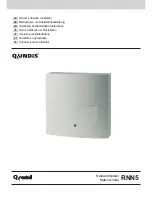
– 154 –
C
HAPTER
4
| Configuring the Switch
IGMP Snooping
◆
IGMP Querier - When enabled, the switch can serve as the Querier
(on the selected interface), which is responsible for asking hosts if they
want to receive multicast traffic. (Default: Disabled)
A router, or multicast-enabled switch, can periodically ask their hosts if
they want to receive multicast traffic. If there is more than one router/
switch on the LAN performing IP multicasting, one of these devices is
elected “querier” and assumes the role of querying the LAN for group
members. It then propagates the service requests on to any upstream
multicast switch/router to ensure that it will continue to receive the
multicast service. This feature is not supported for IGMPv3 snooping.
◆
Compatibility - Compatibility is maintained by hosts and routers
taking appropriate actions depending on the versions of IGMP operating
on hosts and routers within a network. (Range: IGMP-Auto, Forced
IGMPv1, Forced IGMPv2, Forced IGMPv3; Default: IGMP-Auto)
◆
RV - The Robustness Variable allows tuning for the expected packet
loss on a network. A port will be removed from receiving a multicast
service when no IGMP reports are detected in response to a number of
IGMP queries. The robustness variable sets the number of queries on
ports for which there is no report. (Range: 1-255; Default: 2)
Routers adopt the robustness value from the most recently received
query. If the querier's robustness variable (QRV) is zero, indicating that
the QRV field does not contain a declared robustness value, the switch
will set the robustness variable to the value statically configured by this
command. If the QRV exceeds 7, the maximum value of the QRV field,
the robustness value is set to zero, meaning that this device will not
advertise a QRV in any query messages it subsequently sends.
◆
QI - The Query Interval is the interval at which MLD General Queries
are sent by the Querier. (Range: 1-255 seconds; Default: 125 seconds)
An MLD general query message is sent by the switch at the interval
specified by this attribute. When this message is received by
downstream hosts, all receivers build an MLD report for the multicast
groups they have joined.
◆
QRI - The Query Response Interval is the Max Response Time
advertised in periodic General Queries. The QRI applies when the
switch is serving as the querier, and is used to inform other devices of
the maximum time this system waits for a response to general queries.
(Range: 10-31744 tenths of a second; Default: 10 seconds)
◆
LLQI - The Last Listener Query Interval (RFC 3810 – MLDv2 for IP) is
used to configure the Last Member Query Interval for IGMP. This
attribute sets the interval to wait for a response to a group-specific or
group-and-source-specific query message. The overall time to wait for
a response (Last Member Query Time) is the value assigned to LLQI,
multiplied by the Last Member Query Count (which is fixed at 2).
(Range: 1-31744 tenths of a second in multiples of 10;
Default: 1 second)
When a multicast host leaves a group, it sends an IGMP leave message.
When the leave message is received by the switch, it checks to see if
Summary of Contents for EX26262
Page 1: ...Layer 2 Gigabit PoE Ethernet Switch Management Guide...
Page 2: ......
Page 3: ...MANAGEMENT GUIDE...
Page 4: ......
Page 6: ...6 ABOUT THIS GUIDE...
Page 18: ...18 FIGURES...
Page 20: ...20 TABLES...
Page 22: ...22 SECTION I Getting Started...
Page 34: ...34 SECTION II Web Configuration...
Page 46: ...46 CHAPTER 3 Using the Web Interface Navigating the Web Browser Interface...
Page 290: ...290 CHAPTER 5 Monitoring the Switch Displaying Information About Flow Sampling...
Page 294: ...CHAPTER 6 Performing Basic Diagnostics Running Cable Diagnostics 294...
Page 300: ...CHAPTER 7 Performing System Maintenance Managing Configuration Files 300...
Page 302: ...302 SECTION III Appendices...
Page 320: ...GLOSSARY 320...
Page 325: ......
Page 326: ......
















































